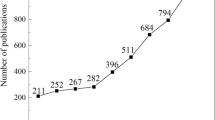Summary
Mapping the after-effects of strong earthquakes, it is suggested, should be performed on the basis of a genetic classification of seismogenic residual deformations of the Earth's crust with separation of a group of accompanying phenomena, indirectly associated with earthquakes. To determine possible maximum earthquakes, locations with the greatest seismic landslide and collapse danger, it is recommended that the palaeoseismogeological method be used.
It is necessary to determine the seismic hazard for engineering constructions both from supposed isoseismal fields and possible types of residual and dynamic seismogenic deformations and accompanying phenomena.
Résumé
On suggère que la cartographie des effects ultérieurs des grands tremblements de terre pourrait être effectuée sur la base d'une classification génétique des déformations résiduelles séismogénétiques de la croûte terrestre, avec séparation d'un groupe de phénomènes concomitants, associés indirectement aux séismes. On recommande d'employer la méthode paléoséismogéologique pour déterminer le tremblement de terre maximal possible, les emplacements des plus grands glissements de terrain d'origine séismique et le danger d'effondrement. Il est nécessaire de déterminer le risque séismique pour les constructions d'ouvrages d'art: d'une part en utilisant un zonage isoséismique hypothétique, et d'autre part d'après les types possibles de déformations séismogénétiques résiduelles et dynamiques, et les phénomènes concomitants.
Similar content being viewed by others
References
GOVI M. (1977): Photo-interpretation and mapping of the landslides triggered by the Friuli earthquake (1976). Bull. Assoc. Engng. Geol. No. 15, 67–72.
HARRISON J.V.—FALCON N.L. (1938): An ancient landslip in Saidmarreh in southern Iran.—Jour. Geology, 46, 296–309.
KURDJUKOV K.V. (1964): Recent tectonic movements and traces of the largest seismic shocks at the nothern slope of the Zaalai ridge.—In: Zones of the Earth's crust with renewed activity, recent tectonic movements and seismicity. Moscow Nauka, 153–159.
MILLER J. (1960): The Alaska earthquake of July 10, 1958; giant wave in Lituya Bay: Bull Seism. Soc. Amer., 50, No. 2, 253–267.
NILSEN TOR H. (1977): Landslides.—Earthquake Information Bull., 9 No. 2, 26–33.
PLAFKER G.—ERICKSEN G.E.—CONCHA J.E. (1971): Geological aspects of the May 31, 1970 Peru earthquake—Bull. Seism. Soc. Amer., 61, No. 3, 543–579.
SOLONENKO, V.P. (1962): Estimation of epicentral zones of earthquakes from geological data.—Izv. AN SSSR, geol. ser., No. 11, 58–74.
SOLONENKO V.P. (1963): Mudflow activity in the Pleistoseist region of catastrophic earthquakes.—Bull. Moscow Society Nature Workers. Geol. section, No. 2, 133–140.
SOLONENKO, V.P. (1965a): Living tectonics in the Pleistoseist area of the Muya earthquake.—Izv. AN SSSR, geol. ser. No. 4, 58–70.
SOLONENKO V.P. (1965 b): Seismic dislocation and associated phenomena. In: The Gobi-Altai earthquake. Florensov N.A. and Solonenko V.P., Ed. Jerusalem- Washington. 271–379.
SOLONENKO V.P. (1972): Seismogenic destruction of mountain slopes.-Intern. Geol. Congr., XXIV Ses., Sec. 13, Engng. Geol. Montreal, 284–290.
SOLONENKO, V.P. (1973): Cryolithzone seismicity and problems of engineering seismogeocryology—II Int. Conf. Permafrost. Reports. Jakutsk, Issue 6, 25–32.
SOLONENKO V.P. (1976): Seismovibrational collapses, and ground avalanches.—In: Geological regularities and interrelation of development of landslides, collapses and mudflows in mountain-folded regions; the prediction basis and struggle against them. Publ. House of MGU, Issue II, 4–18.
SOLONENKO V.P. (1977a): Seismogenic deformations and palaeoseismogeological method. In: Seismicity and seismogeology of East Siberia. Moscow, Nauka, 83–131.
SOLONENKO, V.P. (1977b): Seismic regionalization. In: Seismic regionalization of East Siberia and its geologogeophysical basis. Novosibirsk, Nauka, 261–268.
SOLONENKO V.P. (1977c): Landslides and collapses in seismic zones and their prediction—XXV Int. Geol. Congress.-Bull. Int. Ass. Engng. Geol., No. 15, 4–8.
SOLONENKO V.P.—KHROMOVSKICH V.S. (1974): Strong earthquakes of Great Causasus.—Nature, No. 6, 35–47.
Author information
Authors and Affiliations
Rights and permissions
About this article
Cite this article
Solonenko, V.P. Mapping the after-effects of disastrous earthquakes and estimation of hazard for engineering constructions. Bulletin of the International Association of Engineering Geology 19, 138–142 (1979). https://doi.org/10.1007/BF02600466
Published:
Issue Date:
DOI: https://doi.org/10.1007/BF02600466




